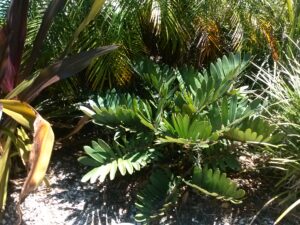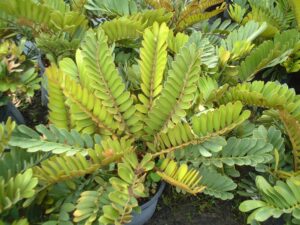S & J Nursery’s Guide to Growing
Cardboard palms / Zamia furfuracea
in the Northeast Florida Jacksonville | St. Augustine area Landscape
Cardboard Palm Origins:
– Zamia f urfuracea is a native of Mexico and although not technically a palm tree but rather a member of the Cycad family, like a Sago, it is a very drought tolerant landscape selection
urfuracea is a native of Mexico and although not technically a palm tree but rather a member of the Cycad family, like a Sago, it is a very drought tolerant landscape selection
for the warmer less frost prone areas of our Northeast Florida Jacksonville | St. Augustine area landscape.
Withstanding cold temperatures down to 20 degrees, these plants may be planted in south Jacksonville, St. Augustine or any other frost free area or microclimate of North Florida landscapes in zones 9 – 11. Hardy in Zones 9B -11.
– This photo was taken of this thriving cardboard palm in a beautiful garden right on the river in the St. Johns area of North Florida.
Cardboard Palm Preferred Exposure:
– Plant Zamia Furfuracea in a partial shade to full shade locution for best results in the North Florida | Jacksonville and St. Augustine area landcape.
Cardboard Palm Fronds | Trunk:
– Gray-green foliage of the Cardboard Palm remains evergreen through the winter in the more southern portions of the North Florida landscape (Zone 10 areas). If planted in a frost prone area or on the Northern end of Climate zone 9 ( 9A ) like the North side or West Jacksonville protect from frosts or use as an indoor or patio plant. Plants in 9B will vary from winter to winter and may sustain some cold damage if not planted in a frost free area of the landscape.
-These showy plants never develop a trunk formation, fronds emerge from underground root systems and are thick and covered with fine hairs. The plant gets its common name from the
thick, rigid foliage similar in feel to cardboard.
Cardboard Palm Soil Preference / Salt  tolerance:
tolerance:
– Cardboard Palms planted in the North Florida | Jacksonville | St. Augustine landscape will tolerate virtually any soil components, providing they are planted into well drained soils.
– Salt tolerance is moderate and plants can be used in coastal areas of the North Florida landscape. Avoid direct salt spray or saline water.
Cardboard Palm Size Variance:
– Zamia Furfuracea plants can reach sizes of 5-6 feet H | and
spreading 5-8 feet in width.
Cardboard Palm Growth Habit:
– Zamia Furfuracea has a low growing, broad spreading habit that will form a
mound of tropical foliage. Adds dramatic bold texture to the landscape.
Cardboard Palm Growth Rate:
– Slow growing member of the Cycad family will take many many years to reach
its potential size.
Cardboard Palm Bloom:
– no flowers, plants are either male or female and female plants can produce a cone like fruit that is quite showy.
Cardboard Palm Water Requirements:
– Extremely drought tolerant once established into the landscape. Cardboard palms store water that can be utilized by the plant during prolonged droughts.
Best Uses For Cardboard Palm in the North Florida | Jacksonville | St. Augustine
Landscape:
– Zamia Furfuracea is an excellent choice for a landscape
statement as its big bold textured foliage is very showy in the landscape and adds instant tropical appeal.
– Excellent potted plant for porches, patio, poolside and even
indoor use!
Care of Cardboard Palm / Zamia Furfuracea Palms:
– Trim back damaged or older browned out fronds each year as needed at the base of the stem to keep the plant at its best.
– Fertilize each spring with a slow release Poly coated plant food like
Osmocote. And each fall with Epsom salt ( Magnesium sulfate ) before the winter temperatures hit.

